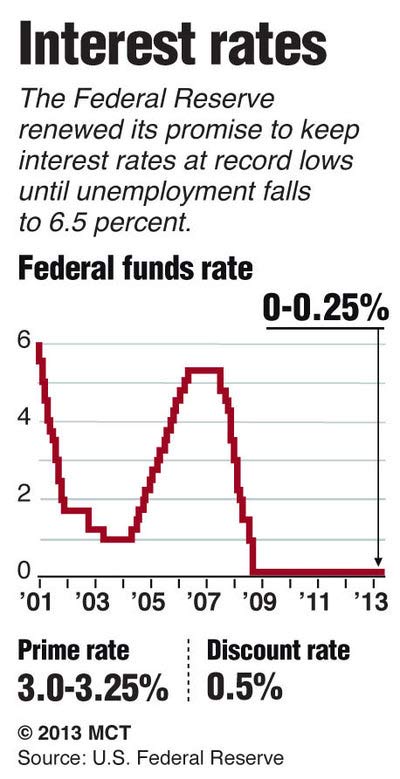Washington – The Federal Reserve, in a carefully worded shift in language, signaled new concern Wednesday that constraints on federal spending are slowing the economy.
The rate-setting Federal Open Market Committee concluded its May meeting by continuing to keep near zero its benchmark federal funds rate, an overnight rate that banks charge one another that influences the costs of borrowing for consumers and businesses alike.
But the real news was in the parsing of Wednesday’s statement from the committee. It was nearly identical to the one issued at the conclusion of its last meeting March 20 but for a slight yet important wording change that indicated the so-called budget sequester and restoration of the full payroll tax now are holding back an anemic recovery.
“Household spending and business fixed investment advanced, and the housing sector has strengthened further, but fiscal policy is restraining economic growth,” the Federal Open Market Committee’s statement said.
That was almost identical to the March wording, except that back then the Fed said that “fiscal policy has become somewhat more constrictive.”
It means that by the Fed’s read of the latest economic indicators, actions taken by Congress and White House – or not taken in the case of failing to reach a budget compromise and allowing automatic cuts to begin on March 1 – are harming the economy and the Fed’s efforts to jumpstart it.
 Another subtle change in the Fed’s language noted that labor market conditions have shown some improvement “in recent months, on balance, but the unemployment rate remains elevated.” The prior statement did not include the “on balance” reference.
Another subtle change in the Fed’s language noted that labor market conditions have shown some improvement “in recent months, on balance, but the unemployment rate remains elevated.” The prior statement did not include the “on balance” reference.
“By caging the language on the labor market with ‘on balance,’ it implies the FOMC sees the weakness in March employment as largely temporary. This means steady-as-she-goes policy,” said Neil Dutta, head of economic research for Renaissance Macro Research in New York.
In other words, it means continuance for the foreseeable future of the Fed’s controversial purchases of government bonds and mortgage bonds in order to drive down their interest rates and force investors to take more risks in the stock market and the broader economy. The Fed’s been purchasing these bonds at a combined rate of $85 billion a month.
“Like a patient who has been administered too many antibiotics, the economy is less and less responsive to the Fed’s continued monetary stimulus,” Rep. Jeb Hensarling, R-Texas, head of the House Financial Services Committee, said in a statement. “America is nearly five years into the Fed’s historically unprecedented interventionist policies and there is very little gain to show for it.” He added: “12 million Americans remain unemployed – a number roughly equal to the entire population of Ohio.”
Mainstream economists expected a slow start to 2013 and for the economy to gain steam by midyear. But the economy grew at a disappointing 2.5 percent from January to March, the Commerce Department reported Friday, held back for the second consecutive quarter by sharp drops in government and defense spending.
Several measures of hiring now are showing a slowdown for employment, and economists are, for the third straight year, scaling back growth estimates.
Fed watchers on Wall Street had expected but did not see new language about a sinking inflation rate, which also points to a weakening economy. The Commerce Department reported Friday that the Fed’s favored gauge of inflation – a mouthful called the personal consumption expenditure price index – increased by 1.2 percent in the first three months of 2013 compared with the same period of 2012.
Inflation is on the rise in prices across the economy and is usually sparked by an economy heating up. The 1.2 percent rise in inflation as measured by the first quarter of each year marked the weakest such reading since late 2008, when a deep financial crisis was unfolding.
Join us in defending the truth before it’s too late
The future of independent journalism is uncertain, and the consequences of losing it are too grave to ignore. To ensure Truthout remains safe, strong, and free, we need to raise $46,000 in the next 7 days. Every dollar raised goes directly toward the costs of producing news you can trust.
Please give what you can — because by supporting us with a tax-deductible donation, you’re not just preserving a source of news, you’re helping to safeguard what’s left of our democracy.
